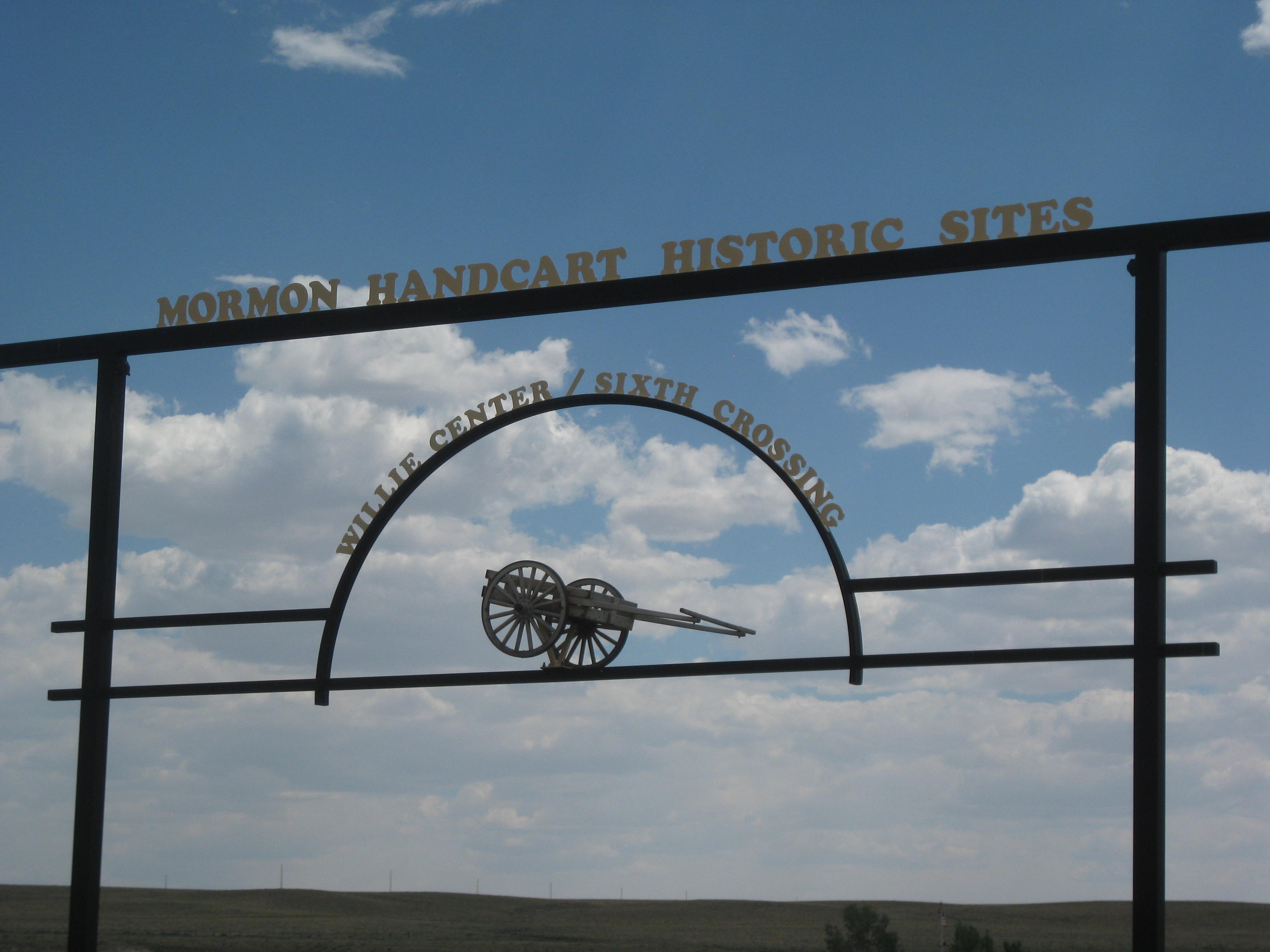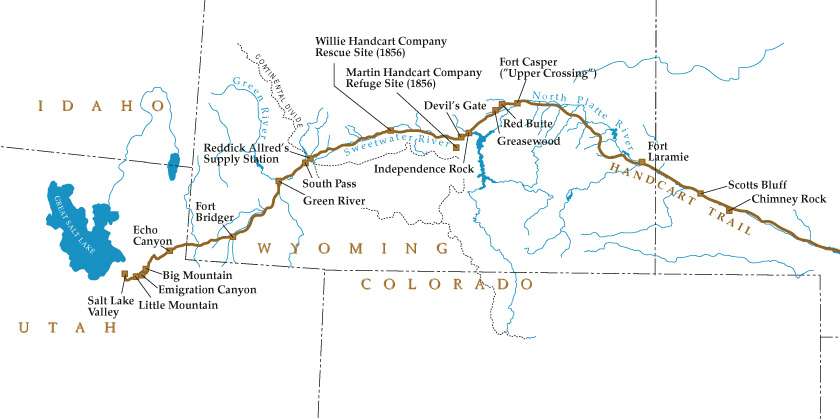 |
Mormon Handcart Historic Sites
Sixth Crossing |
We left the Missionary Training Center in Provo, Utah on April 13, 2016 and drove to our assigned area at Sixth Crossing, Wyoming. Sixth Crossing is not easy to find as it is not on the map, but is located on US Highway 287 about 40 miles east of Lander, Wyoming. Here, on the Sweetwater River more than 500,000 people migrating westward between 1843 and 1869 stopped to rest and recuperate before crossing over the Rocky Mountains. Some of these emigrants came in search of land, some in search of gold and some search of business opportunities, while others came for religious freedom. Most of them settled in California, Oregon, and Utah.
 |
| Handcart Replica |
Of these 500,000 emigrants, between 60,000 – 70,000 were members of The Church of Jesus Christ of Latter-day Saints, also known as Mormons. After being driven from Ohio, Missouri and Illinois, they were seeking refuge from religious persecution – and a place where they could build Zion. Brigham Young led the first group of Latter-day Saint pioneers through this area in 1847, on their way to establishing a settlement in the Salt Lake Valley. Most of the subsequent Mormon emigrants traveled in wagon companies but some traveled by handcarts.
 |
| Mormon Handcart Trail |
In the mid-1850s Brigham Young, the President of the Church, faced a dilemma: thousands of converts from Europe were eager to emigrate, but most of them didn’t have sufficient funds. To make their emigration possible, he developed the "handcart plan". According to this plan, church members would sail from Liverpool to the eastern United States. From there, they would travel by train to the end of the railroad line in Iowa City. From Iowa City they would walk the final 1,300 miles to the Salt Lake Valley, pulling their belongings in two-wheeled handcarts. In contrast to the more than $200 required to outfit a wagon, a handcart could be built for $10 to $20.
 |
| Crossing The Sweetwater River |
The handcart plan was implemented in 1856. Five handcart companies crossed the trail that year. The first three traveled quickly, without difficulties. The last two handcart companies, however, suffered a terrible tragedy. The Willie Handcart Company made it to the Fifth Crossing of the Sweetwater River on October 18, 1856, camped for the night, and prepared for the next day’s journey. The company was exhausted and out of food. The next day they were hit by the season’s first major winter storm near Ice Springs, about 10 miles east of Sixth Crossing. That evening, when they stopped at the Sixth Crossing they killed the last of their cattle. George Cunningham wrote: “. . . they were as poor as we were. We boiled the bones and drank the soup. We ate what little meat there was, we greedily devoured the hide".
 |
| James G. Willie |
Captain Willie knew he must save his company, so on October 20th, with snow blowing in their faces, he and Joseph Elder rode out in search of the relief wagons that had been sent by Brigham Young from Salt Lake City. They thought they would find them 10 – 12 miles west, but did not locate them for 27 miles. The rescue party was also stranded because of the winds and snow. Early the next morning, they all started for the stranded handcart company.
One of the rescuers, Daniel W. Jones, described the condition of the Willie camp when they located it with these words: “On arriving we found them in a condition that would stir the feelings of the hardest heart. They were out of provisions and really freezing and starving to death.” Six of the rescue wagons stayed with the Willie Company and eight others rolled eastward to find the Martin Handcart Company which was struggling under similar conditions. The Willie Company continued on westward, eventually arriving in Salt Lake City November 9th.
 |
| Rescue of the Willie Handcart Company |
Despite the heroic efforts of James Willie, other emigration leaders, and the rescuers, around 69 members of the Willie Handcart Company died along the way. Many survivors suffered effects of the journey throughout their lives, but even those who suffered the most, rarely expressed bitterness or complaint. Much more prevalent in their writings is their gratitude for the restored gospel, for the blessings of the sealing ordinances, and for a loving God. Betsy Smith of the Willie Handcart Company expressed these feelings: “I will not dwell upon the hardships we endured, nor the hunger and cold, but I like to tell of the goodness of God unto us.”
That is one of many legacies left to us by these handcart pioneers – the ability to see the goodness of God even in times of trial and adversity. Their stories are of faith, obedience, sacrifice and charity. It these stories we will be sharing with the visitors who come to walk the California, Oregon and Mormon trails of Wyoming. Come with us, as we journey with these pioneer saints,
Elder and Sister Bowden
 |
| Handcarts Lined Up and Ready To Go |
(Note: material for this posting came from the Wyoming Mormon Trail Mission site manual)








To Begin Any Great Journey You Must Take the First Step . . . and START
ReplyDeleteAdmirable to say the least. I admire the strength and courage of the pioneers. I recently found one of these paintings and was compelled to take it home. It's amazing to see how this painting captures their plight. They pushed and pulled those carts filled with hope and faith.
ReplyDelete